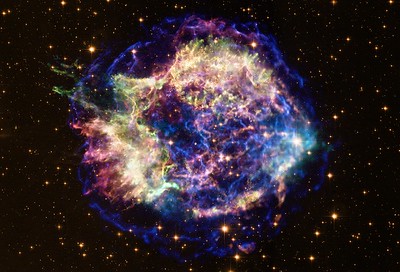When a star runs out of fuel, it succumbs to gravity and collapses. When a star 8 times or more massive than our Sun collapses, it explodes into a supernova. These powerful explosions release more energy in seconds than the Sun has emitted over its entire 10 billion years.
Supernovae blast out high levels of energetic particles known as galactic cosmic rays and intense bursts of electromagnetic waves known as gamma rays. These high-energy emissions are called ionizing radiation, since they strip electrons from molecules they encounter, forming ions. Ionization destroys everything from biomolecules like DNA to particles in the air, called aerosols. Therefore, researchers think a supernova would be catastrophic for any nearby life.
Humans haven’t experienced a close stellar outburst in our lifetime, but our ancestors might not have been so lucky. Supernovae in our planetary neighborhood eject radioactive elements that get trapped in interstellar dust grains, travel across the solar system, and fall on Earth. Geologists tracked these grains in marine muds from the past 10 million years and estimated that a supernova goes off within 100 parsecs of Earth once every million years. Earth is about 8,000 parsecs from the center of the Milky Way, so these stellar explosions are practically on our galactic doorstep!
Scientists in the past proposed that nearby supernovae influenced animal diversity over the past 500 million years by causing mass extinctions. Some researchers hypothesize that cosmic rays from supernovae could destroy Earth’s ozone layer every few hundred million years, exposing surface-dwellers to harmful UV radiation. Others suggest that ionizing radiation could interact with aerosols to produce clouds that block sunlight. However, scientists disagree on how much ozone a supernova would destroy, how severely it would affect the climate, and how badly it would wreck the biosphere.
Researchers recently revisited the destructive potential of nearby supernovae using a model that simulates how the planet’s atmosphere, oceans, land, and biosphere interact, called an Earth system model. They used the Earth System Model with Atmospheric Chemistry, or EMAC, to capture complex processes that previous researchers ignored, like air circulation and chemical reactions. In particular, EMAC uses data from the Cosmics Leaving Outdoor Droplets experiments at CERN to calculate how ions interact with aerosols.
The team used EMAC to simulate Earth today, with 21% atmospheric oxygen, normal radiation levels, and an ozone layer. They subjected their simulated Earth to a blast of ionizing radiation equivalent to a supernova 50 parsecs away by boosting the gamma rays by 10 times for a few seconds, and the galactic cosmic rays by 100 times for a year.
The team examined how a burst of ionizing radiation affected the ozone layer. They confirmed that it stripped electrons from nitrogen and oxygen atoms in the upper atmosphere, producing highly reactive molecules called radicals that can destroy ozone. However, this team found that some radical-forming reactions happened slowly, destroying less ozone than anticipated. They also found that ionizing radiation reacted with water vapor, producing hydroxyl radicals that combined with nitrogen radicals to reform ozone.
Based on these results, the team estimated that a supernova would destroy at most 10% of Earth’s ozone layer, much less than previous researchers suggested. The amount of ozone lost would be roughly equivalent to the 6% destroyed by human fluorocarbons, and far from lethal. They repeated the model with only 2% atmospheric oxygen to simulate Earth around 500 million years ago when life moved onto land, forgoing the ocean’s UV protection. They found that only 10% to 25% of the ozone layer was destroyed at this lower oxygen level.
The team then tracked how radiation from a supernova would affect clouds and the climate. They calculated that ionizing radiation would produce about 10% to 20% more cloud-forming particles worldwide. This change would cool the Earth by roughly 2.5 watts per square meter, about the same magnitude as recent anthropogenic warming. They acknowledged that this change would perturb the environment, but it wouldn’t cause a sudden extinction.
The researchers concluded that radiation from nearby supernovae was unlikely to cause mass extinction events on Earth. Since our primordial ancestors first emerged onto the continents, the atmosphere has acted like a giant umbrella, shielding us from immediate side effects. However, they noted that their models didn’t consider the risks associated with long-term exposure to high levels of ionizing radiation, which are largely unknown. They recommended that future researchers find a safe way to investigate how cosmic radiation directly affects humans and animals.


